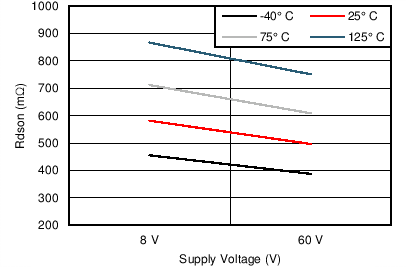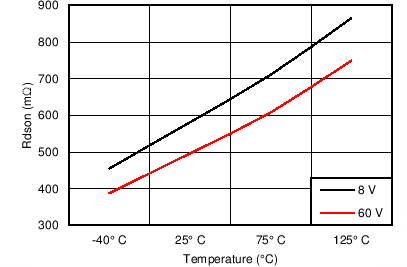SLVSAW3D July 2011 – January 2016 DRV8805
PRODUCTION DATA.
- 1 Features
- 2 Applications
- 3 Description
- 4 Revision History
- 5 Pin Configuration and Functions
- 6 Specifications
- 7 Detailed Description
- 8 Application and Implementation
- 9 Power Supply Recommendations
- 10Layout
- 11Device and Documentation Support
- 12Mechanical, Packaging, and Orderable Information
Package Options
Mechanical Data (Package|Pins)
Thermal pad, mechanical data (Package|Pins)
- PWP|16
Orderable Information
6 Specifications
6.1 Absolute Maximum Ratings
over operating free-air temperature range (unless otherwise noted)(1)(2)| MIN | MAX | UNIT | ||
|---|---|---|---|---|
| VM | Power supply voltage | –0.3 | 65 | V |
| VOUTx | Output voltage | –0.3 | 65 | V |
| VCLAMP | Clamp voltage | –0.3 | 65 | V |
| Digital input pin voltage | –0.5 | 7 | V | |
| nHOME, nFAULT |
Digital output pin voltage | –0.5 | –0.5 to 7 | V |
| nHOME, nFAULT |
Output current | 20 | mA | |
| Peak clamp diode current | 2 | A | ||
| DC or RMS clamp diode current | 1 | A | ||
| Peak motor drive output current, t < 1 μS | Internally limited | A | ||
| Continuous total power dissipation | See Thermal Information | |||
| TJ | Operating virtual junction temperature | –40 | 150 | °C |
| Tstg | Storage temperature | –60 | 150 | °C |
(1) Stresses beyond those listed under Absolute Maximum Ratings may cause permanent damage to the device. These are stress ratings only, which do not imply functional operation of the device at these or any other conditions beyond those indicated under Recommended Operating Conditions. Exposure to absolute-maximum-rated conditions for extended periods may affect device reliability.
(2) All voltage values are with respect to network ground terminal.
6.2 ESD Ratings
| VALUE | UNIT | ||||
|---|---|---|---|---|---|
| V(ESD) | Electrostatic discharge | Human body model (HBM), per ANSI/ESDA/JEDEC JS-001, all pins(1) | ±3000 | V | |
| Charged device model (CDM), per JEDEC specification JESD22-C101, all pins(2) | ±1000 | ||||
(1) JEDEC document JEP155 states that 500-V HBM allows safe manufacturing with a standard ESD control process.
(2) JEDEC document JEP157 states that 250-V CDM allows safe manufacturing with a standard ESD control process.
6.3 Recommended Operating Conditions
| MIN | NOM | MAX | UNIT | ||
|---|---|---|---|---|---|
| VM | Power supply voltage | 8.2 | 60 | V | |
| VCLAMP | Output clamp voltage (2) | 0 | 60 | V | |
| IOUT | Continuous output current, single channel on, TA = 25°C, SOIC package(1) | 1.5 | A | ||
| Continuous output current, four channels on, TA = 25°C, SOIC package(1) | 0.8 | ||||
| Continuous output current, single channel on, TA = 25°C, HTSSOP package(1) | 2 | ||||
| Continuous output current, four channels on, TA = 25°C, HTSSOP package(1) | 1 | ||||
(1) Power dissipation and thermal limits must be observed.
(2) VCLAMP is used only to supply the clamp diodes. It is not a power supply input.
6.4 Thermal Information
| THERMAL METRIC(1) | DRV8805 | UNIT | ||
|---|---|---|---|---|
| DW (SOIC) | PWP (HTSSOP) | |||
| 20 PINS | 16 PINS | |||
| RθJA | Junction-to-ambient thermal resistance | 67.7 | 39.6 | °C/W |
| RθJC(top) | Junction-to-case (top) thermal resistance | 32.9 | 24.6 | °C/W |
| RθJB | Junction-to-board thermal resistance | 35.4 | 20.3 | °C/W |
| ψJT | Junction-to-top characterization parameter | 8.2 | 0.7 | °C/W |
| ψJB | Junction-to-board characterization parameter | 34.9 | 20.1 | °C/W |
| RθJC(bot) | Junction-to-case (bottom) thermal resistance | N/A | 2.3 | °C/W |
(1) For more information about traditional and new thermal metrics, see the Semiconductor and IC Package Thermal Metrics application report, SPRA953.
6.5 Electrical Characteristics
TA = 25°C, over recommended operating conditions (unless otherwise noted)| PARAMETER | TEST CONDITIONS | MIN | TYP | MAX | UNIT | |
|---|---|---|---|---|---|---|
| POWER SUPPLIES | ||||||
| IVM | VM operating supply current | VM = 24 V | 1.6 | 2.1 | mA | |
| VUVLO | VM undervoltage lockout voltage | VM rising | 8.2 | V | ||
| LOGIC-LEVEL INPUTS(SCHMITT TRIGGER INPUTS WITH HYSTERESIS) | ||||||
| VIL | Input low voltage | 0.6 | 0.7 | V | ||
| VIH | Input high voltage | 2 | V | |||
| VHYS | Input hysteresis | 0.45 | V | |||
| IIL | Input low current | VIN = 0 | –20 | 20 | μA | |
| IIH | Input high current | VIN = 3.3 V | 100 | μA | ||
| RPD | Pulldown resistance | 100 | kΩ | |||
| nFAULT OUTPUT (OPEN-DRAIN OUTPUT) | ||||||
| VOL | Output low voltage | IO = 5 mA | 0.5 | V | ||
| IOH | Output high leakage current | VO = 3.3 V | 1 | μA | ||
| nHOME OUTPUT (OPEN-DRAIN OUTPUT WITH WEAK INTERNAL PULLUP) | ||||||
| VOL | Output low voltage | IO = 5 mA | 0.5 | V | ||
| VOH | Output high voltage | IO = 100 µA, VM = 11 V – 60 V, peak | 6.5 | V | ||
| IO = 100 μA, VM = 11 V – 60 V, steady state | 3.3 | 4.5 | 5.6 | |||
| IO = 100 μA, VM = 8.2 V – 11 V, steady state | 2.5 | |||||
| ISRC | Output source current | VM = 24 V | 1 | mA | ||
| ISNK | Output sink current | VM = 24 V | 5 | mA | ||
| LOW-SIDE FETS | ||||||
| RDS(ON) | FET on resistance | VM = 24 V, IO = 700 mA, TJ = 25°C | 0.5 | Ω | ||
| VM = 24 V, IO = 700 mA, TJ = 85°C | 0.75 | 0.8 | ||||
| IOFF | Off-state leakage current | –50 | 50 | μA | ||
| HIGH-SIDE DIODES | ||||||
| VF | Diode forward voltage | VM = 24 V, IO = 700 mA, TJ = 25°C | 1.2 | V | ||
| IOFF | Off-state leakage current | VM = 24 V, TJ = 25°C | –50 | 50 | μA | |
| OUTPUTS | ||||||
| tR | Rise time | VM = 24 V, IO = 700 mA, Resistive load | 50 | 300 | ns | |
| tF | Fall time | VM = 24 V, IO = 700 mA, Resistive load | 50 | 300 | ns | |
| PROTECTION CIRCUITS | ||||||
| IOCP | Overcurrent protection trip level | 2.3 | 3.8 | A | ||
| tOCP | Overcurrent protection deglitch time | 3.5 | µs | |||
| tRETRY | Overcurrent protection retry time | 1.2 | ms | |||
| tTSD | Thermal shutdown temperature | Die temperature(1) | 150 | 160 | 180 | °C |
(1) Not production tested.
6.6 Timing Requirements
over operating free-air temperature range (unless otherwise noted)(1)| MIN | NOM | MAX | UNIT | |||
|---|---|---|---|---|---|---|
| 1 | fSTEP | Step frequency | 250 | kHz | ||
| 2 | tWH(STEP) | Pulse duration, STEP high | 1.9 | µs | ||
| 3 | tWL(STEP) | Pulse duration, STEP low | 1.9 | µs | ||
| 4 | tSU(STEP) | Setup time, DIR, SMx to STEP rising | 1 | µs | ||
| 5 | tH(STEP) | Hold time, DIR, SMx to STEP rising | 1 | µs | ||
| 6 | tOE(ENABLE) | Enable time, nENBL to output low | 50 | ns | ||
| 7 | tPD(L-H) | Propagation delay time, STEP to OUTx, low to high | 500 | ns | ||
| 8 | tPD(H-L) | Propagation delay time, STEP to OUTx, high to low | 500 | ns | ||
| — | tRESET | RESET pulse width | 20 | µs | ||
(1) Not production tested.
 Figure 1. DRV8805 Timing Requirements
Figure 1. DRV8805 Timing Requirements
6.7 Typical Characteristics



